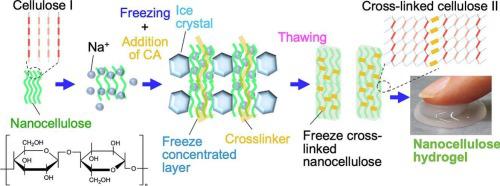当前位置:
X-MOL 学术
›
Carbohydr. Polym.
›
论文详情
Our official English website, www.x-mol.net, welcomes your
feedback! (Note: you will need to create a separate account there.)
Nanocellulose hydrogels formed via crystalline transformation from cellulose I to II and subsequent freeze cross-linking reaction
Carbohydrate Polymers ( IF 10.7 ) Pub Date : 2023-12-01 , DOI: 10.1016/j.carbpol.2023.121538 Yurina Sekine 1 , Takuya Nankawa 2 , Kosuke Hiroi 3 , Yojiro Oba 4 , Yoshiyasu Nagakawa 5 , Tsuyoshi Sugita 1 , Yuki Shibayama 1 , Tomoko Ikeda-Fukazawa 6
Carbohydrate Polymers ( IF 10.7 ) Pub Date : 2023-12-01 , DOI: 10.1016/j.carbpol.2023.121538 Yurina Sekine 1 , Takuya Nankawa 2 , Kosuke Hiroi 3 , Yojiro Oba 4 , Yoshiyasu Nagakawa 5 , Tsuyoshi Sugita 1 , Yuki Shibayama 1 , Tomoko Ikeda-Fukazawa 6
Affiliation

|
We describe nanocellulose (NC) hydrogels formed from chemically unmodified NC by cellulose crystalline transformation and subsequent freeze cross-linking reaction. The freeze cross-linked NC hydrogel with macropores (~100 μm) was prepared by freezing a mixture of NC and NaOH (0.2 mol L−1 ), adding citric acid to the frozen mixture, and thawing it. Using NaOH and freezing together induced the crystalline transformation of NC from cellulose I to II via freeze concentration. After the crystalline transformation, cross-linking between the NC and CA in the freeze concentration layer provided a strong NC network structure, forming NC hydrogels with high mechanical strength. The structural changes in NC caused by NaOH, freezing, and freeze cross-linking on the angstrom to micrometer scale were investigated with FT-IR, SAXS, PXRD, and SEM. The freeze cross-linked NC hydrogel easily retained powder adsorbents in its inner space by mixing the NC-NaOH sol and the powder, and the hydrogel showed high removal efficiency for heavy metals. The results highlight the versatility of chemically unmodified celluloses in developing functional materials and suggest possible practical applications. This study also provides new insights into the efficient use of chemical reactions of cellulose under freezing conditions.
中文翻译:

通过纤维素 I 到 II 的结晶转化和随后的冷冻交联反应形成的纳米纤维素水凝胶
我们描述了由化学未修饰的 NC 通过纤维素结晶转化和随后的冷冻交联反应形成的纳米纤维素 (NC) 水凝胶。通过冷冻 NC 和 NaOH 的混合物 (0.2 mol L-1),向冷冻混合物中加入柠檬酸,然后解冻来制备具有大孔 (~100 μm) 的冷冻交联 NC 水凝胶。同时使用 NaOH 和冷冻通过冷冻浓缩诱导 NC 从纤维素 I 到 II 的结晶转变。结晶转变后,冷冻浓缩层中 NC 和 CA 之间的交联提供了强大的 NC 网络结构,形成了具有高机械强度的 NC 水凝胶。用 FT-IR、SAXS、PXRD 和 SEM 研究了 NaOH、冻结和冻结交联在埃到微米尺度上引起的 NC 结构变化。冷冻交联 NC 水凝胶通过混合 NC-NaOH 溶胶和粉末,很容易将粉末吸附剂保留在其内部空间,并且水凝胶对重金属表现出较高的去除效率。结果突出了化学未改性纤维素在开发功能材料中的多功能性,并提出了可能的实际应用。这项研究还为在冷冻条件下有效利用纤维素的化学反应提供了新的见解。
更新日期:2023-12-01
中文翻译:

通过纤维素 I 到 II 的结晶转化和随后的冷冻交联反应形成的纳米纤维素水凝胶
我们描述了由化学未修饰的 NC 通过纤维素结晶转化和随后的冷冻交联反应形成的纳米纤维素 (NC) 水凝胶。通过冷冻 NC 和 NaOH 的混合物 (0.2 mol L-1),向冷冻混合物中加入柠檬酸,然后解冻来制备具有大孔 (~100 μm) 的冷冻交联 NC 水凝胶。同时使用 NaOH 和冷冻通过冷冻浓缩诱导 NC 从纤维素 I 到 II 的结晶转变。结晶转变后,冷冻浓缩层中 NC 和 CA 之间的交联提供了强大的 NC 网络结构,形成了具有高机械强度的 NC 水凝胶。用 FT-IR、SAXS、PXRD 和 SEM 研究了 NaOH、冻结和冻结交联在埃到微米尺度上引起的 NC 结构变化。冷冻交联 NC 水凝胶通过混合 NC-NaOH 溶胶和粉末,很容易将粉末吸附剂保留在其内部空间,并且水凝胶对重金属表现出较高的去除效率。结果突出了化学未改性纤维素在开发功能材料中的多功能性,并提出了可能的实际应用。这项研究还为在冷冻条件下有效利用纤维素的化学反应提供了新的见解。

































 京公网安备 11010802027423号
京公网安备 11010802027423号